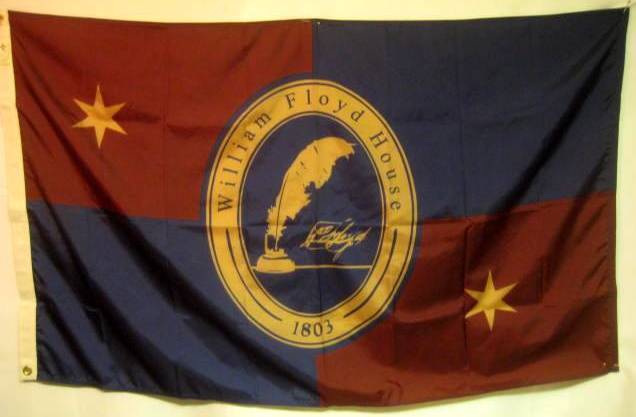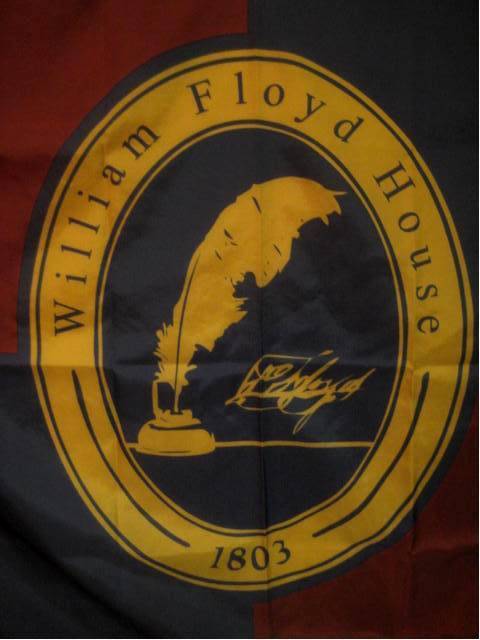|
|
Page Title:
The William Floyd Flag
#H178 $89.00
3x5' Nylon with
heading and grommets

A most unique historical project; The only flag to commemorate
the life and home of a Signer of the Declaration of Independence. William Floyd
was one of four signers from New York State
History has become my lifestyle and I owe my interest in it to my
flag business. Contact with Civil War reenactors who came to me as customers in
the early 1980's got me listening to the stories of their regiments and battles. Those reenactors introduced me to history. From there my interest
grew to include all eras of American History with a particular focus on our
colonial and founding periods. In that context I have been visiting homes and
graves of the signers of The Declaration of Independence as well as every
birthplace, home, grave and library of all US Presidents. I am about 75% done
with this quest.
One of the best parts of my business has been the places it has
taken me and the people I have met. I first got introduced to The Marriotts also
as customers. After a few years of taking orders from them on the phone, it came out in conversation that they own
the house of William Floyd, a signer of The Declaration, in Westernville, NY.
This house appears in a book on The Declaration of Independence that was in our
house when I was growing up and, with my new found interest as an adult, I had
always wondered if it was still standing. See the story below about their
stewardship of The William Floyd House.
Somehow it came out that they had designed a flag for The Floyd
House. One thing led to another and we struck an arrangement to sell this flag
here to benefit their work in preserving the home of a signer. Here is what Russ
Marriott explains about the flag's design:
"The two colors we chose have always appealed to me for some time
and are appropriate for this particular signer. The use of blue stems from
receipts that have survived and are archived at the William Floyd Estate that
indicate that Floyd, upon arriving in Philadelphia had a suit made with fine
blue cloth and star-spangled buttons. This was quite a departure for this very
modest, conservative farmer from Long Island. The two stars represent his two
houses he called home and six pointed shape is simply a nod to Washington's
position flag star design. At some time, someone had given me this article on
the symbolism of the color red. It indicated that red symbolized energy, passion
and action and is said to be associated with our most physical needs and our
will to survive. Perhaps some of these thought filled William's head as came to
understand the significance to his action of signing the declaration of
Independence. The date of 1803 is the year he moved into the house in Western.
Although it was not yet completed, it was substantial enough for his occupancy.
In September of 2011, the Western Floyd family was the host family for the
Descendants of the Signers of the Declaration of Independence and most of the
activities revolved around the house."
 The
seal features William Floyd's signature The
seal features William Floyd's signature
Only 56 men signed the Declaration of Independence and homes
still stand from only about a dozen of them.
So there it is. A most unique flag, designed by a most unique
family, for a most unique house, from a most unique 18th century man.
|
|
William Floyd House, Westernville, NY
1803
At an age when most people would be satisfied with
reflecting upon their life-long success and service to their country, a
68-year-old General William Floyd left his family estate on Long Island.
Together with his second wife, their two daughters, and entrusted servants and
slaves, Floyd ventured up the Mohawk Valley to the central part of New York
State and settled into their newly constructed home. The General had purchased
large tracts of land in this region after the War for Independence. He chose a
site in a fertile valley, south of the headwaters of the Mohawk River. This area
was about eight miles north of Fort Stanwix, a fort that had played a pivotal
role in defeating the British attempt to divide the Colonies during the
Revolution. In 1803, this area was considered beyond the civilized boundaries of
colonial settlement.
William Floyd was, by nature and by occupation, a
farmer and businessman. He loved the freedom, opportunity, and independence that
farming afforded him and was successful in his endeavors. In the early days of
the Revolution, it was those successful business skills and leadership qualities
that caused the people of Suffolk County, Long Island to send William to the
Continental Congress. He served two terms, from 1774-1777 and again from
1779-1783. At the meeting of the Second Continental Congress, he would
immortalize himself in American history by signing the Declaration of
Independence. Later, the General would serve in the New York State Senate, the
New York State Constitutional Convention of 1801, as a member of the House of
Representatives of the first Federal Congress and as a Presidential Elector on
four occasions.
Early in the 19th century, free from the rigorous
responsibilities of political service and after a failed bid for the office of
Lieutenant-Governor of New York State, William Floyd was able to devote himself
to his love of farming at his new home in Western. The house, thought to be
designed by Floyd, allowed him to resolve a number of architectural conflicts he
inherited at his Long Island homestead. The architectural style he chose
reflected the conservative personality of the Signer. At a time when people of
his means where being swept up in the new Federalist architectural movement,
Floyd was quite comfortable in designing his new home in the classical Georgian
style. Although high style for the colonial frontier, the house would have been
considered old fashioned by urban colonial standards.
The house was originally a center hall, post and beam
structure, comprised of eleven rooms. It sat on substantial acreage, with
numerous outbuildings. Before the mid 1800s, two of these outbuildings were
attached to the main structure forming a two-story wing. Currently, the house
consists of 21 rooms and one original outbuilding, on eight acres in a quiet
country village. Time has been kind to the Generalís upstate home, having
survived virtually intact. It has been home to five owners since leaving the
possession of the Floyd family in1951. The house was declared a National
Historic Landmark in 1971. Itís current owners, Dr. Russell and Jaclyn Marriott,
have owned the house since 1977. The philosophy of the on-going restoration and
preservation reflects a respect for all the efforts of the previous owners,
while focusing on the period in which General William Floyd occupied his estate.
Although the Generalís home is not open to the public,
the current owners/caretakers attempt to share this piece of American history
through both the written and Internet medias.
|
| |
| |
|

 The
seal features William Floyd's signature
The
seal features William Floyd's signature